Kidnapped and disappeared during Argentina’s brutal 1976-1983 military dictatorship, Pablo Míguez was a special case for various reasons. On the one hand, he was a disappeared child who does not enter into the normal category of “born in captivity.” Furthermore, there are multiple witness statements remembering that dark era that affirm that the military kidnap squads were not in the habit of taking underage children if possible. And if abducted, those kids were later released.
First, Pablo was just 14 when he went missing, one of the youngest apart from those who were snatched from their mother’s arms in captivity and had their identities stolen. Second, because Pablo’s life in captivity represented a dilemma for the repressors and he was treated differently from others who had been abducted. Third, and finally, because there is little information published about him and nor is there any certainty as to the youngster’s fate.
Pablo Antonio Míguez was born in 1963. He disappeared in 1977. He was abducted together with his mother, Irma Beatriz Márquez Sayago, and Jorge Antonio Capello Davi, Irma’s partner since she had separated from Pablo’s father. The couple continues to be missing to this day.
Jorge Antonio Capello Davi was the elder brother of Eduardo Capello, one of the 16 people shot at the Massacre of Trelew in 1972 after escaping from Rawson Prison, for which those responsible have since been convicted for crimes against humanity.
When Eduardo Capello was killed in Trelew, his brother Jorge spoke to judges, newspapers and on television.
“From then on he was blacklisted. They later raided his house and started to persecute him,” testified Soledad Davi, the mother of the two brothers.
The disappearance of Pablo Míguez, his mother and Jorge Antonio is thus linked to the Massacre of Trelew.
Eduardo
Jorge and Irma had another child, the aforementioned Eduardo. On the day of the abduction he was in the care of his grandmother. He was a baby when his parents and step-brother disappeared.
Eduardo, the brother of Pablo Míguez, son of Jorge and Irma, nephew of Eduardo Adolfo and grandson of Soledad Davi, speaks with this newspaper.
“My uncle was one of the 16 murdered. All those families linked to [the Massacre of] Trelew were persecuted by the dictatorship after 1972. Many of them went into exile, others into hiding and, in my case, went missing. My uncle, mum, dad and brother were victims of state repression,” relates Eduardo.
“Pablo was an introverted kid, cheerful and intelligent. He had suffered a lot.”
Pablo Míguez was the oldest child and had a sister Graciela (born to Irma and Juan Carlos, like Pablo), two years younger than him. At the time of the abduction, Graciela was with her father. Pablo was 14 and Graciela 12, while Eduardo had just celebrated his second birthday.
“Irma, ‘Nené’, my mum, got to know my dad Jorge in the Partido Revolucionario de los Trabajadores. An intense love story arose between them. I was born in 1975. On May 12, 1977, a hit squad entered our Avellaneda home and took away Irma, Jorge and Pablo,” narrates Eduardo.
“Pablo was an introverted kid, cheerful and intelligent. He had suffered a lot. When they kidnapped him, they took him to the ‘El Vesubio’ clandestine detention centre, using him to make my parents talk .They made him witness the tortures and his mum being repeatedly raped. And that is where the dilemma for the military came up. Pablo was too small to kill but too big to let go because he had already seen too much,” he continued.
Pablo was transferred to the clandestine detention centre functioning at the ESMA Navy Mechanics School where he crossed paths with the journalist Lila Pastoriza, a rare survivor of the death camp.
Pastoriza was held there between 1977 and 1978, and while they were together, Pablo told her part of his story, which the journalist entrusted herself with making public. The other detainees called him ‘Pablito.’
Pastoriza and Míguez shared a month in the highest of the ESMA lofts. In her testimony, entitled ‘Un pibe con cara de travieso (“A kid with a naughty face”)’, Lila wrote: “Pablo told me of Vesubio, of the prisoners transferred from there after an official communiqué had given them as ‘fallen in combat,’ of his mum to whom he could not bid farewell because ‘she was in the kitchen,’ of his hopes of being taken away with his father, of his life in the outside world, school, swimming, his siblings, his grandmother, his cousins and horse-racing, of his loves and fears. We had found a form of talking blindfolded without being noticed, each of us lying face down on our bunk or kneeling against the wooden partition separating us.
“I doubled him in years but we looked after each other mutually. I tried to protect him, above all on nights when he woke up crying: ‘I dreamed of my mum.’ And when he told me that he had been tortured with an electric cattle prod and I lost control, he would tell me desperately: ‘It didn’t hurt me that much’ to calm me down.”
“They took away a kid of 14 and used him in their torture plans.”
In the eventual 2021 court sentence condemning the repressors of El Vesubio, the testimony of other detention centre survivors may be read: “It was remembered that Violeta (the name given to Pablo’s mother) brought them cigarettes and dulce de batata sweet potato spread, telling them that she knew they were going to kill her but the only thing which mattered to her was saving her son. She said that she was tortured in front of the child and they threatened to torture the kid if she did not talk. (...) A voice was heard screaming: ‘Mum, mum’ and afterwards it was known to be Pablo Míguez. (...) Seeing and hearing that boy, who as the days went by calmed down and afterwards disappeared, was said to be unbearable.”
In 1977 Pablo’s father Juan Carlos lodged a habeas corpus writ which was rejected by the courts.
The pose of the child in the statue now standing in the waters of the River Plate was taken as a reference from a snapshot by Pablo’s father at the same age as his abduction.
Eduardo revealed that his family did not conserve many photos: they were burnt during the dictatorship as a form of protection.
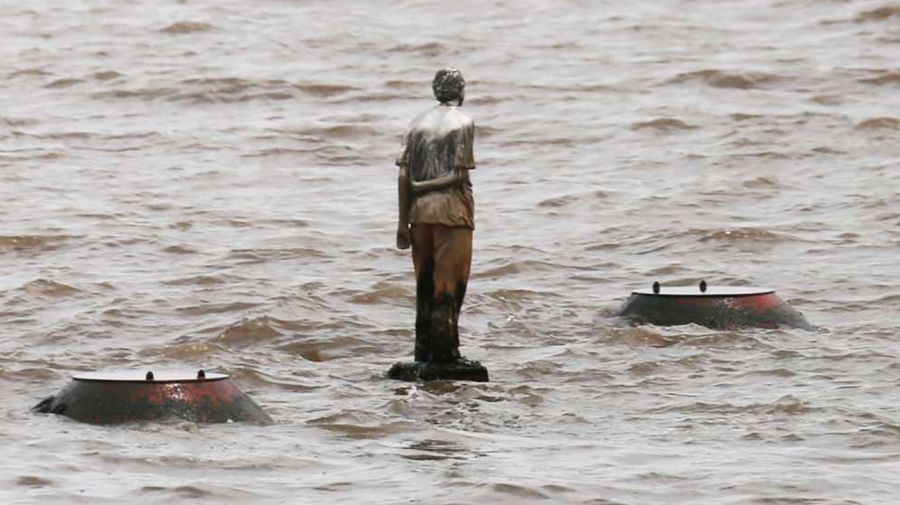
Dilemma
The dilemma as to what to do with Pablo was present from the very first moment of his abduction. Pastoriza narrates that when ‘Pablito’ was transferred to ESMA, she heard one officer say to another: “Look at what we’re having to dedicate ourselves now... he’s just 14.”
“He was so young, so vivacious, he appeared so defenceless in that crazy world that not a few guards were moved by his presence. (...) I wanted to believe then that they would free him. Who could send a boy of 14 to his death? The day before the Trial of the Juntas at the Tribunales central courthouse somebody gave me a flyer with his photo, reading: ‘Pablo Míguez, desaparecido’,” said Pastoriza.
“When I was in ESMA, he was very thin with long hair and a very sad face. There was no further trace of him as from mid-1978,” says his brother. “But they did not break us. They killed my parents in late 1977. They were part of the death flights.”
Nothing is known of Pablo’s fate, which is believed to have been the same as his mother’s. The location of the Parque de la Memoria statue makes sense – it overlooks the River Plate into which many of the victims of the last dictatorship were hurled, including Pablo’s mother and perhaps he himself.
“Pablo’s age is not a minor issue. In August 1975, when the military broke into the Pujadas home in Córdoba, and took away most of the family, Mariano’s younger brother José was sleeping in a bedroom. The military woke him up and asked him: ‘How old are you, laddie?’ ‘11,’ he replied. ‘You’ve had a lucky escape, we don’t kill anybody under 15,’ said the soldier and left after locking him up in a bathroom along with his 11-month-old niece,” relates Eduardo Capello.
Nothing is known of Pablo’s fate, which is believed to have been the same as his mother’s.
Everybody in the Pujadas family except José, was abducted and killed. Mariano Pujadas was another Massacre of Trelew victim.
“Two years later the criteria had already changed. They took away a kid of 14 and used him in their torture plans,” affirms Eduardo.
An extract from the El Vesubio court sentence: “The letter ‘M’ corresponded to Montoneros (...) and “V” to “Various”, (...) who in principle might possibly be released ... The fate presumed by the letter was not always respected since, for example, Pablo Míguez had the letter ‘V’ and was not saved.”
Pablo was also seen held at the Mansión Seré detention centre, La Plata Prison Unit N° 9 de La Plata and the 2nd police precinct of Valentín Alsina. In the trial of the Mansión Seré repressors, a witness testified that no officer was in charge of that “very cheerful, lucid, intelligent and full of life” kid, unlike the other detainees. Others also testified having seen ‘Pablito’ playing chess with various guards in uniform and that the boy “was free to go around anywhere.” When they took him away, they told his mother that he was being transferred to a reform school.
Case history
The first person to find out what had happened to her family was the grandmother looking after Eduardo since Irma never returned with her son. The grandmother testified that when she got home, the doors and windows were open and that neighbours told her that the abduction was at 3am with “a group of heavily armed persons machine-gunning the door” entering the dwelling. Five months later, when she returned to visit the house, all the furniture, even the taps, had been robbed.
“A neighbour said that an armed group numbering between 8 and 10 had shown up, taking everything in the house,” said a witness.
The location of the Parque de la Memoria statue makes sense – it overlooks the River Plate into which many of the victims of the last dictatorship were hurled, including Pablo’s mother and perhaps he himself.
“I grew up in a home heavily marked by the tragedy of the military dictatorship, remaining in the care of my paternal grandparents. When my parents disappeared, I was a baby. Currently I’m much linked to the Massacre of Trelew and the trial of the repressors of Vesubio, where my mum, dad and brother were. All my life has been marked by this question of Memory, Truth and Justice,” maintains Eduardo. His grandmother Soledad Davi was one of the founders of the Mothers of Plaza de Mayo, testifying in 2011 at the ‘Causa El Vesubio’ trial.
“I was left without children,” she told the judges.
In 1979, Soledad sent a letter to the Cuban representative at the United Nations asking him to intercede with the UN Human Rights Committee in the case of the abduction of her son, Jorge Antonio Capello. The letter concludes: “We are only left with a little boy of three who somehow helps us to live. He and we need to know what happened to them. I beg of you again to do your bit and not forget our pain.” The case of Pablo Míguez appears in the Grandmothers of Plaza de Mayo archives in the section “Children who went missing with their parents.”
Pablo Míguez would be close to 60 today. They say that when pilots take off from Aeroparque Jorge Newbery Airport and fly over him, they cross themselves when they pass his sculpture.










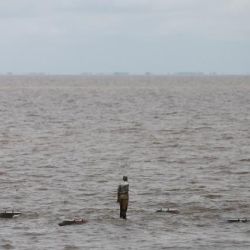
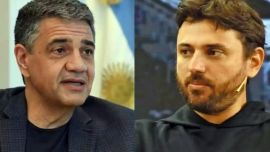






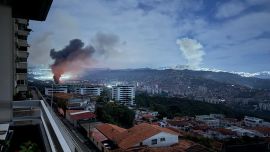

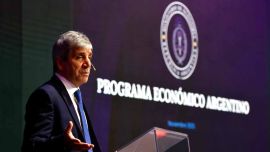
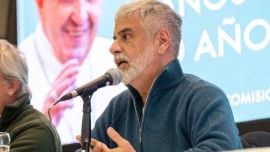

Comments